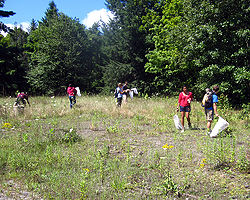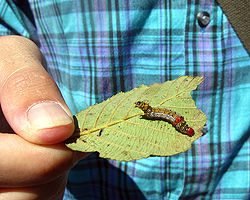Difference between revisions of "General Entomology"
Kevin Keegan (Talk | contribs) |
Kevin Keegan (Talk | contribs) |
||
| Line 82: | Line 82: | ||
| September 1 || Importance of insects<br>Introduction to insect diversity<br><!--{{pdf|http://hydrodictyon.eeb.uconn.edu/courses/entomology/restricted/Insect%20Importance%2028%20August.pdf}} Importance of insects-->|| || Insect walk<br>Collecting methods<br>Pinning<br>|| | | September 1 || Importance of insects<br>Introduction to insect diversity<br><!--{{pdf|http://hydrodictyon.eeb.uconn.edu/courses/entomology/restricted/Insect%20Importance%2028%20August.pdf}} Importance of insects-->|| || Insect walk<br>Collecting methods<br>Pinning<br>|| | ||
|- | |- | ||
| − | | Sept 6 || | + | | Sept 6 || Insect adaptations|| '''Quiz 1''': Insect Collecting || Overview of Insect Orders<br>|| |
|- | |- | ||
| Sept 8 || External Anatomy I<br>|| || External Grasshopper Anatomy|| | | Sept 8 || External Anatomy I<br>|| || External Grasshopper Anatomy|| | ||
| Line 94: | Line 94: | ||
| Sept 20 || Internal Anatomy I|| '''Quiz 3''': Insect Anatomy || Non-insect arthropods|| | | Sept 20 || Internal Anatomy I|| '''Quiz 3''': Insect Anatomy || Non-insect arthropods|| | ||
|- | |- | ||
| − | | Sept 22 || | + | | Sept 22 || Internal Anatomy II and Fossil History I|| || Blattodea, Mantodea, Phasmatodea, Orthoptera<br>Collecting around TLS<br>|| |
|- | |- | ||
| − | | Sept 27 || | + | | Sept 27 || Fossil History II|| '''Quiz 4''': Primitive insect orders+<br>Aquatic insects || Dermaptera, Plecoptera, Pscodea|| |
|- | |- | ||
| − | | Sept 29 || Growth and phylogeny | + | | Sept 29 || Growth and phylogeny|| Collection check #1|| Thysanoptera, Hemiptera I (aquatic)|| |
|- | |- | ||
| − | | Oct 4 || '''MIDTERM 1''' || || Hemiptera II (Heteroptera) | + | | Oct 4 || '''MIDTERM 1''' || || Hemiptera II (Heteroptera)|| |
|- | |- | ||
| − | | Oct 6 || | + | | Oct 6 || Growth and Molting|| || Hemiptera III (Aucheno- and Sternorrhyncha, Fulgoroidea)|| |
|- | |- | ||
| − | | Oct 11 || Growth and Molting II<br> | + | | Oct 11 || Growth and Molting II<br>Nervous System I|| || Neuropterida|| |
|- | |- | ||
| − | | Oct 13 || | + | | Oct 13 || Nervous System II|| '''Quiz 5''': Hemimetabola || Aquatic ecology field trip|| |
|- | |- | ||
| − | | Oct 18 || | + | | Oct 18 || Behavior I|| || Strepsiptera, Coleoptera I|| |
|- | |- | ||
| − | | Oct 20 || Behavior II<br> | + | | Oct 20 || Behavior II<br>Social Insects I|| || Coleoptera II|| |
|- | |- | ||
| Oct 25 || Acoustical insects (Dr. Charles Henry)<br>{{pdf|http://hydrodictyon.eeb.uconn.edu/courses/entomology/restricted/4250lec26_sound.pdf}}Acoustical insects || || Coleoptera III<br>{{pdf|http://hydrodictyon.eeb.uconn.edu/courses/entomology/restricted/lab%2017_coleoptera%20III_BZ_2014.pdf}}Coleoptera III||<!--{{pdf|http://hydrodictyon.eeb.uconn.edu/courses/entomology/restricted/reading_For%20Love%20of%20Insects_2012.PDF}}For Love of Insects<br>{{pdf|http://hydrodictyon.eeb.uconn.edu/courses/entomology/restricted/reading_Insect%20Lives_2012.PDF}}Insect Lives--> | | Oct 25 || Acoustical insects (Dr. Charles Henry)<br>{{pdf|http://hydrodictyon.eeb.uconn.edu/courses/entomology/restricted/4250lec26_sound.pdf}}Acoustical insects || || Coleoptera III<br>{{pdf|http://hydrodictyon.eeb.uconn.edu/courses/entomology/restricted/lab%2017_coleoptera%20III_BZ_2014.pdf}}Coleoptera III||<!--{{pdf|http://hydrodictyon.eeb.uconn.edu/courses/entomology/restricted/reading_For%20Love%20of%20Insects_2012.PDF}}For Love of Insects<br>{{pdf|http://hydrodictyon.eeb.uconn.edu/courses/entomology/restricted/reading_Insect%20Lives_2012.PDF}}Insect Lives--> | ||
Revision as of 22:31, 31 August 2016
EEB 4250 - General Entomology
Fall 2016
Day/Time: Tuesday+Thursday Lecture 12:30-1:20 Lab 1:30 3:30
Place: Storrs campus, Torrey Life Sciences Room 313
Credits: 4
Instructor: David Wagner
- Torrey Life Sciences Rm 471
- 860-486-2139 and 860-942-1796 (cell)
- Office hours: 10 MWF and as available
TA: Kevin Keegan
- Torrey Life Sciences Rm 461
- 617-272-5054 (cell)
- Office hours: as available (email for appointment)
Textbook:
- Borror, DJ and RE White, 1970. Peterson Field Guide to Insects: America North of Mexico.
- Gullan, P. J. and P. S. Cranston. 2010. The Insects: An Outline of Entomology. Fourth Ed. Blackwell Science, Oxford, England.
Introduction
The lectures provide a broad introduction to insect diversity, phylogeny, structure and function, behavior, ecology, and conservation. The laboratory stresses sight identification and natural history of 120 common insect families. The collection requirement connects the lecture and laboratory by linking lecture topics, and especially insect behavior and ecology, to Connecticut’s extraordinary insect fauna.
Course Procedures and Policies
Academic Integrity:
Plagiarism and cheating are violations of the student conduct code, and may be punished by failure in the course or, in severe cases, dismissal from the University. For more information, see Appendix A of the Student Conduct Code.
Disabilities:
If you have a disability for which you may be requesting an accommodation, you should contact a course instructor and the Center for Students with Disabilities (Wilbur Cross Building, Room 201) within the first two weeks of the semester.
Syllabus and Course Materials
| Item | Points |
|---|---|
| Midterms (100 pts each) | 200 pts |
| Final | 175 pts |
| Collection | 300 pts |
| 7 lab quizzes (25 pts each), attendance (25 pts) and participation (25 pts) | 225 pts |
| Lab practicum | 80 pts |
| Current events (2 articles) | 20 pts |
| Total | 1000 pts |
Collection Materials
 Collection Guidelines
Collection Guidelines Label Template
Label Template Collection Excel Sheet
Collection Excel Sheet Ecological Labels
Ecological Labels Collection Check #1
Collection Check #1 Odonate Label Template
Odonate Label Template Collection Check #2
Collection Check #2
| Date | Lecture | Quiz | Lab | Readings |
|---|---|---|---|---|
| August 30 | Course overview | Wagner Lab visit Collections Facility Intro to collections |
| |
| September 1 | Importance of insects Introduction to insect diversity |
Insect walk Collecting methods Pinning |
||
| Sept 6 | Insect adaptations | Quiz 1: Insect Collecting | Overview of Insect Orders |
|
| Sept 8 | External Anatomy I |
External Grasshopper Anatomy | ||
| Sept 9-11 | Great Mountain Forest Trip | |||
| Sept 13 | External Anatomy II | Quiz 2: Insect Orders | Internal anatomy dissection | |
| Sept 15 | External Anatomy III | Aquatic insects Aquatic field trip |
||
| Sept 20 | Internal Anatomy I | Quiz 3: Insect Anatomy | Non-insect arthropods | |
| Sept 22 | Internal Anatomy II and Fossil History I | Blattodea, Mantodea, Phasmatodea, Orthoptera Collecting around TLS |
||
| Sept 27 | Fossil History II | Quiz 4: Primitive insect orders+ Aquatic insects |
Dermaptera, Plecoptera, Pscodea | |
| Sept 29 | Growth and phylogeny | Collection check #1 | Thysanoptera, Hemiptera I (aquatic) | |
| Oct 4 | MIDTERM 1 | Hemiptera II (Heteroptera) | ||
| Oct 6 | Growth and Molting | Hemiptera III (Aucheno- and Sternorrhyncha, Fulgoroidea) | ||
| Oct 11 | Growth and Molting II Nervous System I |
Neuropterida | ||
| Oct 13 | Nervous System II | Quiz 5: Hemimetabola | Aquatic ecology field trip | |
| Oct 18 | Behavior I | Strepsiptera, Coleoptera I | ||
| Oct 20 | Behavior II Social Insects I |
Coleoptera II | ||
| Oct 25 | Acoustical insects (Dr. Charles Henry) |
Coleoptera III |
||
| Oct 27 | Forensic entomology (Dr. William Krinsky) |
Coleoptera review | ||
| Nov 1 | Social insects II |
Quiz 6: Megaloptera, Neuroptera, Strepsiptera, and Coleoptera | Trichoptera, Lepidoptera |
|
| Nov 3 | Social insects III, Insects and plants |
Greenhouse Tour Bug jeopardy |
||
| Nov 8 | MIDTERM II | Mecoptera, Siphonaptera, Diptera I |
||
| Nov 10 | Insects and plants II |
Collection Check #2 | Diptera II |
Chpt. 13, 14 Comet Orchid |
| Nov 15 | Insects and plants III Medical entomology |
Diptera III | Chapter 15 | |
| Nov 17 | Medical entomology II |
Hymenoptera I |
Robotic cockroach | |
| Nov 29 | Chemical ecology of insects (Scott Smedley |
Quiz 7: Mecopteroidea | Open lab | |
| Dec 1 | Insect Ecology |
Hymenoptera II |
||
| Dec 6 | Pest management and biological control |
Live Insect Project due Aquatic assignment due |
Bug Banquet Open lab |
Chapter 16 |
| Dec 8 | Insect conservation |
LAB PRACTICUM | Open lab | |
| Dec ?? | FINAL EXAM | COLLECTION DUE |
Collection Tips
1) Ensure your name is clearly written on all boxes.
2) Please keep your vials in an easy-to-access container.
3) You must hand in a printed spreadsheet (found on the course website) along with your collection. Your name must be on it. The written families should be in the same order as the specimens in your boxes.
4) Don't forget about the ecological labels. Think about them carefully, this is an easy way to make mistakes if you rush.
5) Put the labels in the right order on the pin. Locality label on top, then species label (if needed), then ecological label (if needed), then family label (if it's the first in the row). Labels should be in line with the specimen and take up as little space as possible and still be legible. They should all be facing the same direction.
6) Organization of orders/families within the box is unimportant, as long as it is clear. Try to condense to as few boxes as possible.
7) Remember that the curation guidelines are to ensure that your specimens are "museum ready" - they might be your longest legacy on earth. Think about how beautifully well organized Dave's collection is upstairs, and the main collection next door. Look at your specimens and ask if they are ready to be seamlessly integrated into a museum collection.
8) Don't fret too much about a bad specimen (missing legs, etc) if it's the only one you have. Damaged specimens are still valuable if properly labeled.
9) Moderate trading is encouraged.
10) Some specimens will be taken and added to the main collection (you should take this as a compliment, I had several of my specimens taken). If you have a favorite specimen you are particularly attached to, like something you raised as a pet, leave a note on your spreadsheet.


